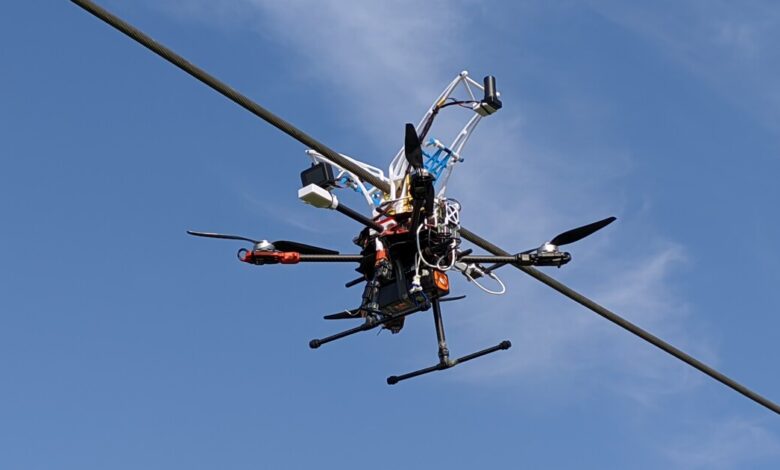Crafty quadcopter sits on power lines to recharge

Battery life wouldn’t be an issue for drones if they could just recharge on power lines as needed. That’s exactly what an experimental new quadcopter can now do, allowing it to stay aloft pretty much indefinitely.
Developed by scientists from the University of Southern Denmark, the charging technology could be utilized by drones carrying out a wide variety of tasks. That said, it’s intended first and foremost for use by autonomous drones performing power line inspections. After all, those copters are already going to be within easy reach of the lines at all times.
Viet Duong Hoang and colleagues started with a commercial Tarot 650 Sport carbon fiber drone frame, then added an electric quadcopter propulsion system, a 7,000-mAh lithium-polymer battery, and electronic components such as a Raspberry Pi 4 B microcomputer, a Pixhawk V6X autopilot module, plus a millimeter-wave radar unit and an RGB video camera.
Importantly, they also installed a passively actuated power-line-gripper on top of the drone. This device sits within a cable guide consisting of two widely spread inward-sloping arms.
University of Southern Denmark
When the drone’s onboard software detects that its battery is getting low, the aircraft uses its camera and radar to spot the closest power line. The aircraft then flies straight up toward that line from underneath.
Upon reaching the power line, the drone’s cable guide directs the line into the gripper. As the line goes in, it pushes down on two elastomer ribbons spanning the open space between the gripper’s two rubber sides. This action causes those sides to quickly close together overtop of the power line – no electricity required.
That said, once the line has been gripped, a magnetic control circuit kicks in to power the gripper, keeping it firmly closed around the line as the drone hangs beneath. A top-located inductive charger on the drone then starts drawing current from the power line. Once the aircraft’s battery is fully charged, the gripper opens and the drone can resume its line-inspecting duties.
It should be noted that only a small amount of upward thrust by the drone is required to initially trip the gripper. Additionally, if the voltage of the power line is sufficient, it serves as the power source for the control circuit – otherwise, the drone’s battery is used.
In field tests performed on power lines at Denmark’s HCA Airport, the 4.3-kg (9.5-lb) demonstrator drone was able to operate for over two hours, recharging its battery five times between line-inspection sessions. The scientists are now working on boosting the system’s robustness, and hope to test it in both more remote locations and adverse weather conditions.
You can see the drone in power-line-gripping action, in the video below. A paper on the research is being presented at The 2024 IEEE International Conference on Robotics and Automation.
And for another take on power-line-inspecting drone-like things, check out the LineRanger robot, which crawls along lines instead of flying overtop of them.
Autonomous Overhead Powerline Recharging for Uninterrupted Drone Operations – ICRA 2024
Source: University of Southern Denmark




